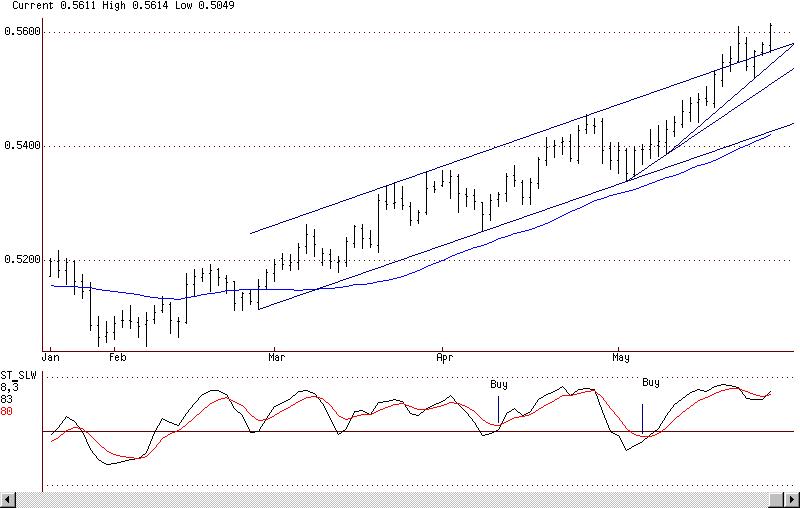Lesson 6
Stochastics
History
George Lane was the originator of the sochastics in the 1970's. Lane observed that as prices increase in an up trend, closing prices tend to be closer to the upper end of bars and in a down trend closing prices tend to be nearer the lower end of bars. Lane developed stochastics to discern the relationship between the closing price and the high and low of a bar. Typically used to identify overbought and oversold conditions the indicator consists of two lines: % K and %D. These two lines fluctuate in a vertical range between 0 and 100. Readings above 80 are considered overbought and readings below 20 are considered oversold. When the faster %K line crosses above the slower %D line and the lines are below 20, a buy signal is generated. When the %K lines crosses below the %D line and the lines are above 80 a sell signal is generated.
My Own use Of Stochastics
Well as usual just to be contrary to everyone I don't use the stochastics to signal overbought or oversold although I do take note of the readings. I like to use them as possible buy and sell opportunities after defining a trend. If the trend is up as in the example below on the AUD (Australian Dollar) I like to only take buy signals regardless of the reading as long as the trend remains in place. I ignore the sell signals. I purposefully weaken the stochastics to give me more signals and I use 8,3,3 as my settings. This gives more signals and shows the hand of the weaker players. The same is true of selling in a down trend. I ignore the buy signals and only take the sell signals. I don't use stochastics on their own as trading method as all the settings I have tried ultimately resulted in to many wipsaws. Experiment with different settings and consider adding this indicator to your trading arsenal. Good trading.

Lesson 7
ADX (Average Directional Index)
History
Average Directional Index (ADX) was developed by J. Welles Wilder Jr. and as its name implies attempts to measure the strength of the direction the security is moving in. ADX is measured in a scale from 0-100 with readings above 25 indicating that you are in a trend whilst readings below 25 indicate that you are not in a trend. As the scale is measured from 0-100 it doesn't matter if the trend is up or down, the scale and reading are still from 0-100 e.g. if you were in a strong down trend the reading might be 45. You might get the exact same reading if you were in a strong up trend. The reason I mention this is that many of my students get confused when first introduced to ADX and see the indicator rising as the trend goes down (see charts). Wilder himself admitted that ''Directional movement is the most fascinating concept I have ever studied'' 'New Concepts In Technical Trading Systems'. Readings of over 60 are fairly rare in my observations and once they are at the extremes can actually mean the direction is getting ready for a change. See First chart below.ЎҫҪ»ТЧЦӘК¶macd.org.cnКХјҜХыАнЎҝ
My Own use Of ADX
I highly recommend this little technique. You may not get that many signals but when you do they will be high probability. I like to use a 21 period moving average on the time period I am trading. First the ADX must be 30 or over, no action is taken unless the ADX has achieved this reading. Next the security must retrace to its 21 period moving average. Once these two conditions have been met you can enter the market. Once in the market keep two things in mind. Have a tight stop on the initial entry, perhaps above the most recent high or most recent low depending on direction or even a dollar amount. Next, be aware of the last high or low once in trade e.g. the ADX has a reading 30 or above, the security makes a high and then retraces to the 21 period moving average. Your first target should be the last high or you should at least pay close attention to what happens to price around that level. The same goes for the short trade. You have a reading of 30 or above and it makes a new low. It then pulls back to the 21 period moving average and you enter short. Your first target should be the previous low or monitor closely at that price level.
